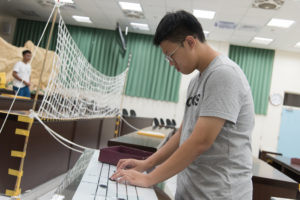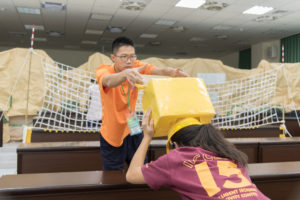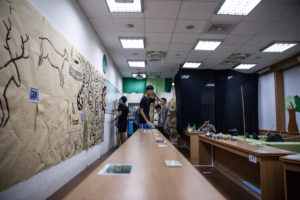「樂球重建」仰賴音準 「卡利伊希奈」考驗語言能力


智慧鐵人創意競賽決賽關卡充滿巧思,體其組關卡「樂球重建」的故事背景,描述經歷一場大火後,大部分的樂譜都被燒毀,而小鐵人需要運用線索,來復原遺失的樂譜。關卡除了需要基本的樂理知識,還考驗團隊間的傳球默契。
The final tasks of IICC are full of ingenuity. The backstory of the physical fitness task “Fly Me to the Moon” describes that many music sheets were burned out after fire. The students need to use hints to recover them. The task demand music theory and good teamwork on passing balls.
關卡的中央有一個巨大的排球網,兩旁的桌上擺放了四張空白的五線譜,整個設計以排球為原型,並融入音樂元素,增添更多趣味性。關卡中有四首曲子等待小鐵人們一一排出正確的音符,完成空白的樂譜。
In the middle of the room, there is a huge volleyball net, and both sides have four blank sheets music on the tables. The origin of the task is volleyball. It involves the element of music to make it funnier. There are four songs which need to be finished by the students. The students need to put he notes at the correct place on the blank sheets music.
然而,即便解開牆上的題目搭配絕佳的聽音能力只能完成部份的樂譜,若想完成完整的樂譜,則須仰賴隊友們的互助合作,將箱子內的球傳過球網並送至指定位置,才能獲得額外的音符,完成完整的樂譜。《亞美非回來了》隊笑稱:「如果你們隊伍有一個音準天才,那直接聽歌其實就會對了。」
However, the students can only finish part of the sheet music after solving the quizzes on the wall. If they want to complete all of the sheet music, they have to pass the balls which are in the boxes to the specific place. Then they will receive extra notes to finish the sheet music. Team AAAS is back said, “If there’s a music genius, then you can solve the quiz by listening to the music.”
關主何其恩認為,團隊合作在這個關卡特別重要,參賽隊伍必須要在短短的30分鐘內完成任務,加上許多題目不只一種解法,如何找到更快速的方法,則考驗著他們突破框架的能力。
The taskmaster, CHI-EN HE, said that teamwork is the most needed ability in this task. The team has to finish the task in 30 minutes. Some of the quizzes have more than one solution, so finding a faster way to solve it needs to think outside the box.


另外,藝文類關卡「卡利伊希奈」,則考驗小鐵人們的聽力和理解能力。「卡利伊希奈」是阿美族語豐年祭的意思,關卡中運用了大量的阿美族語,關主謝文崴表示,關卡的設計發想是由於先前參加了介紹排灣族語的講座,便想將原住民語融入關卡中,在蒐集資料後,決定使用有網路資源的阿美族語。
The literature & arts advanced task “Kilisinan” tests the students’ listening and comprehensive ability. “Kilisinan” means harvest festival in the language of Amis. The language of Amis is the core element of the task. The taskmaster, WEN-WEI HSIEH, said that they designed this task because a lecture about the language of Paiwan. So they tried to integrate aboriginal language into the task. After searching information online, they chose the language of Amis which has the most resources on the internet.
在關卡中,小鐵人們都是部落的居民,但長期在外地工作的他們早已遺忘了母語,但他們又須遵循長老的吩咐舉辦一場傳統祭典,從沒學過阿美族語的他們,究竟該如何完成長老的指示呢?
In the task, the students are the resident in the tribe. They had already forgotten their mother language after working at other places. But they had to follow the instructions from the elder to hold a traditional harvest festival. But they have never learnt the language before. How could they accomplish the mission of the elder?
關主謝文崴表示,關卡裡頭有許多相關聯的圖片以及單字,運用地理與音樂相關的知識解開線索,再根據這些線索,小鐵人們便能夠拼湊出長老的話中所提到的物品,除此之外,關卡也測驗小鐵人們的觀察力與統整能力,因此這個關卡具有一定的難度。不過基路伯聯隊仍表示,參加智鐵競賽三年,終於遇上原住民語關卡,相當感動。
The taskmaster, WEN-WEI HSIEH, said that there are many pictures and words in the task. The students need to use the knowledge of geography and music to solve quizzes. Follow the clues, the students could find out what the instructions from the elder’s words. Additionally, the task can test their observation and Integration ability. Team said, Cherubim Union said, “We had joined IICC for three years, finally met a task about the language of Taiwanese aborigines. I’m deeply moved. And the task was pretty fun.”
不論是體其或是藝文關卡,在在都考驗著小鐵人們的各項能力,但最重要的仍是互助合作,才有機會取得佳績,從眾多競爭者中脫穎而出。(記者劉潔謙、林于暄/屏東科大採訪報導)
All of physical fitness or literature & arts advanced tasks challenge the students’ different abilities. However, teamwork is the key point to get higher scores, and stand out from the competitors. (by Chieh Chien Liu and Yu Xuan Lin)